Primary Source Report: The Beaver Fur Hat and Canadian History
VerifiedAdded on 2023/04/21
|9
|1357
|325
Report
AI Summary
This report provides a primary source analysis of a beaver fur hat, exploring its significance in Canadian history. The report describes the artifact, its materials, and its historical context within the 17th to 19th centuries, highlighting its popularity among the elite in North America and Europe. It emphasizes the beaver fur trade's crucial role in Canada's economic growth, cultural interactions between aboriginals and European settlers, and its political influence. The analysis covers the trade's environmental impact, the rise of companies like Hudson's Bay Company, and the socio-cultural implications of immigration and relationships with indigenous populations. The report concludes that the beaver fur hat serves as an important artifact, narrating the economic, cultural, and historical progress of Canada, and that Desklib has similar solved assignments for students.
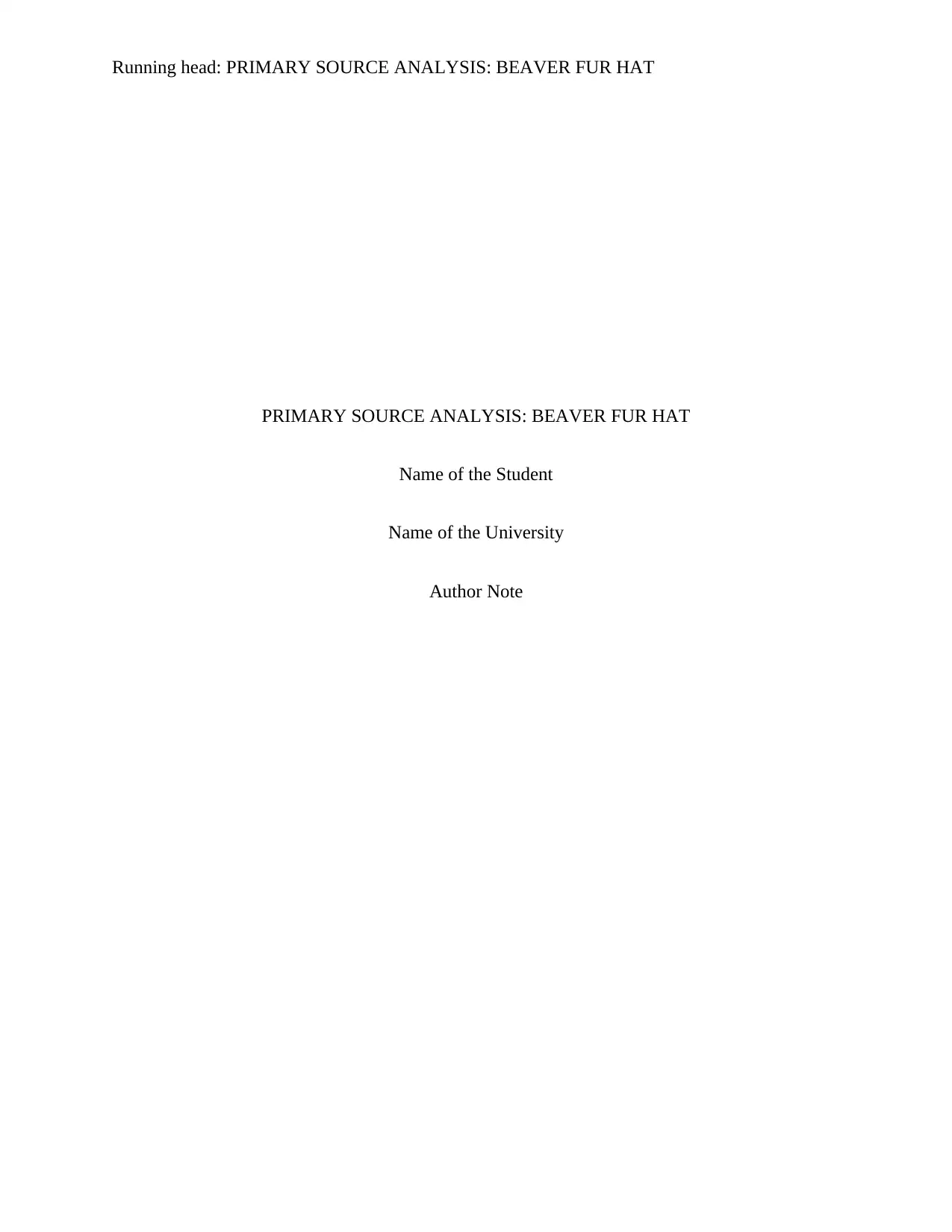
Running head: PRIMARY SOURCE ANALYSIS: BEAVER FUR HAT
PRIMARY SOURCE ANALYSIS: BEAVER FUR HAT
Name of the Student
Name of the University
Author Note
PRIMARY SOURCE ANALYSIS: BEAVER FUR HAT
Name of the Student
Name of the University
Author Note
Paraphrase This Document
Need a fresh take? Get an instant paraphrase of this document with our AI Paraphraser
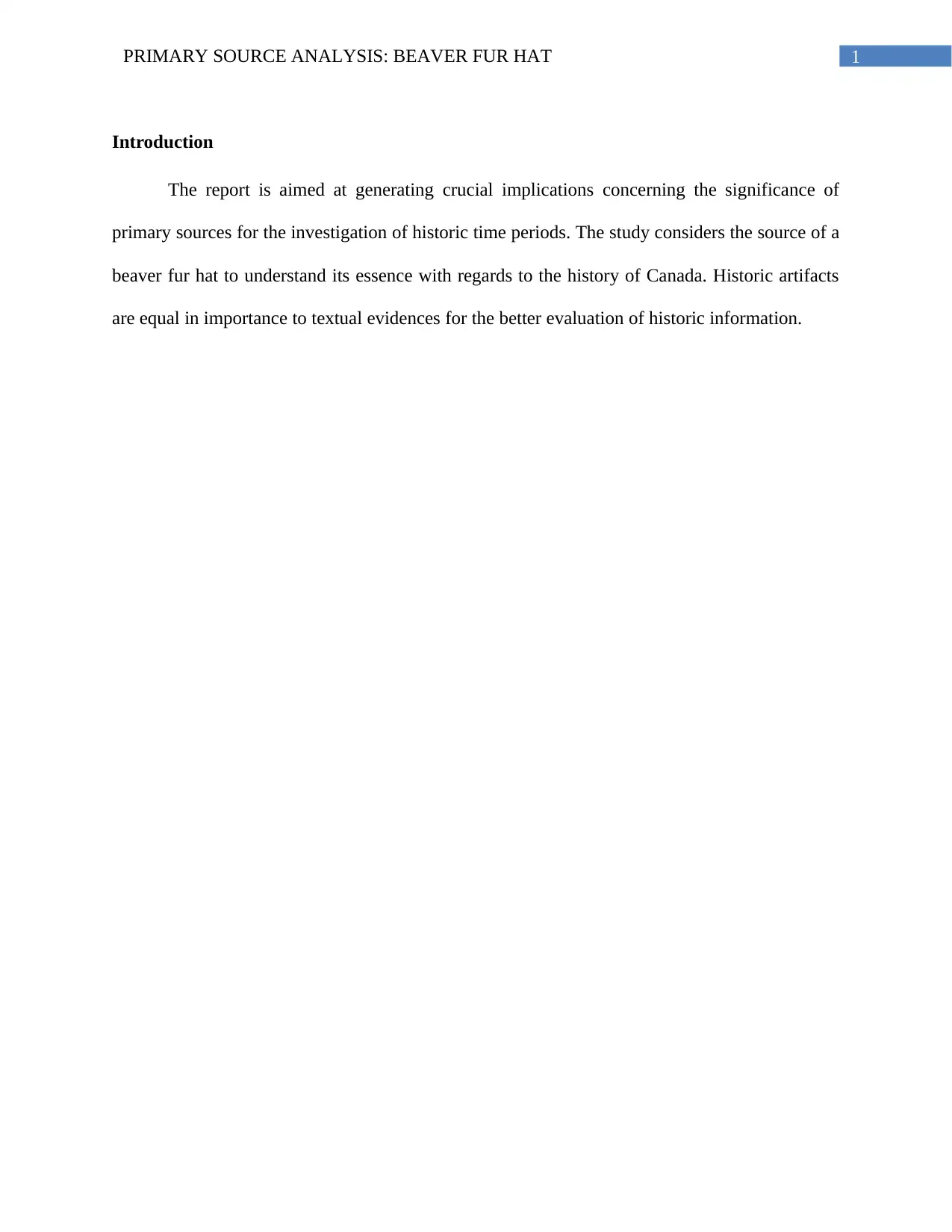
1PRIMARY SOURCE ANALYSIS: BEAVER FUR HAT
Introduction
The report is aimed at generating crucial implications concerning the significance of
primary sources for the investigation of historic time periods. The study considers the source of a
beaver fur hat to understand its essence with regards to the history of Canada. Historic artifacts
are equal in importance to textual evidences for the better evaluation of historic information.
Introduction
The report is aimed at generating crucial implications concerning the significance of
primary sources for the investigation of historic time periods. The study considers the source of a
beaver fur hat to understand its essence with regards to the history of Canada. Historic artifacts
are equal in importance to textual evidences for the better evaluation of historic information.
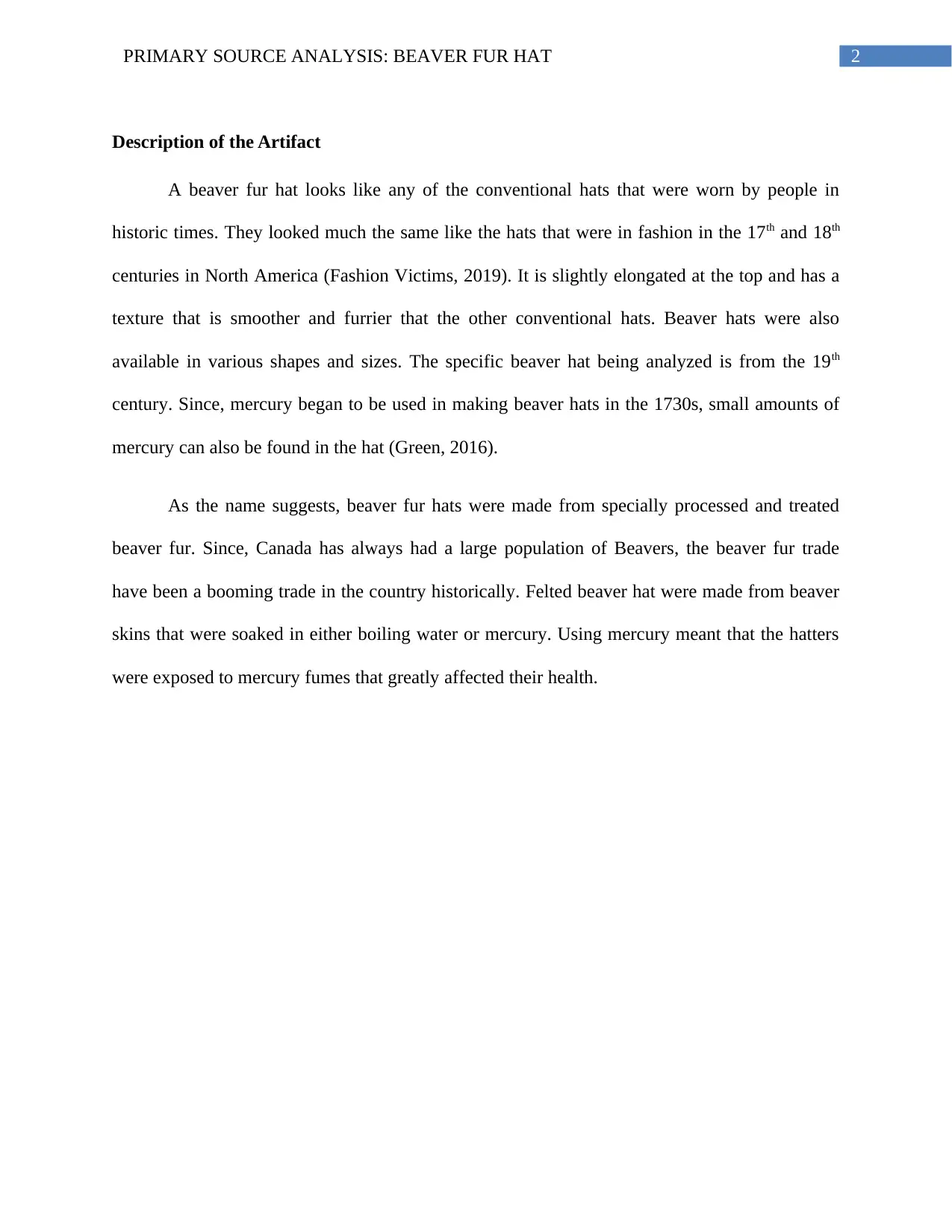
2PRIMARY SOURCE ANALYSIS: BEAVER FUR HAT
Description of the Artifact
A beaver fur hat looks like any of the conventional hats that were worn by people in
historic times. They looked much the same like the hats that were in fashion in the 17th and 18th
centuries in North America (Fashion Victims, 2019). It is slightly elongated at the top and has a
texture that is smoother and furrier that the other conventional hats. Beaver hats were also
available in various shapes and sizes. The specific beaver hat being analyzed is from the 19th
century. Since, mercury began to be used in making beaver hats in the 1730s, small amounts of
mercury can also be found in the hat (Green, 2016).
As the name suggests, beaver fur hats were made from specially processed and treated
beaver fur. Since, Canada has always had a large population of Beavers, the beaver fur trade
have been a booming trade in the country historically. Felted beaver hat were made from beaver
skins that were soaked in either boiling water or mercury. Using mercury meant that the hatters
were exposed to mercury fumes that greatly affected their health.
Description of the Artifact
A beaver fur hat looks like any of the conventional hats that were worn by people in
historic times. They looked much the same like the hats that were in fashion in the 17th and 18th
centuries in North America (Fashion Victims, 2019). It is slightly elongated at the top and has a
texture that is smoother and furrier that the other conventional hats. Beaver hats were also
available in various shapes and sizes. The specific beaver hat being analyzed is from the 19th
century. Since, mercury began to be used in making beaver hats in the 1730s, small amounts of
mercury can also be found in the hat (Green, 2016).
As the name suggests, beaver fur hats were made from specially processed and treated
beaver fur. Since, Canada has always had a large population of Beavers, the beaver fur trade
have been a booming trade in the country historically. Felted beaver hat were made from beaver
skins that were soaked in either boiling water or mercury. Using mercury meant that the hatters
were exposed to mercury fumes that greatly affected their health.
⊘ This is a preview!⊘
Do you want full access?
Subscribe today to unlock all pages.

Trusted by 1+ million students worldwide
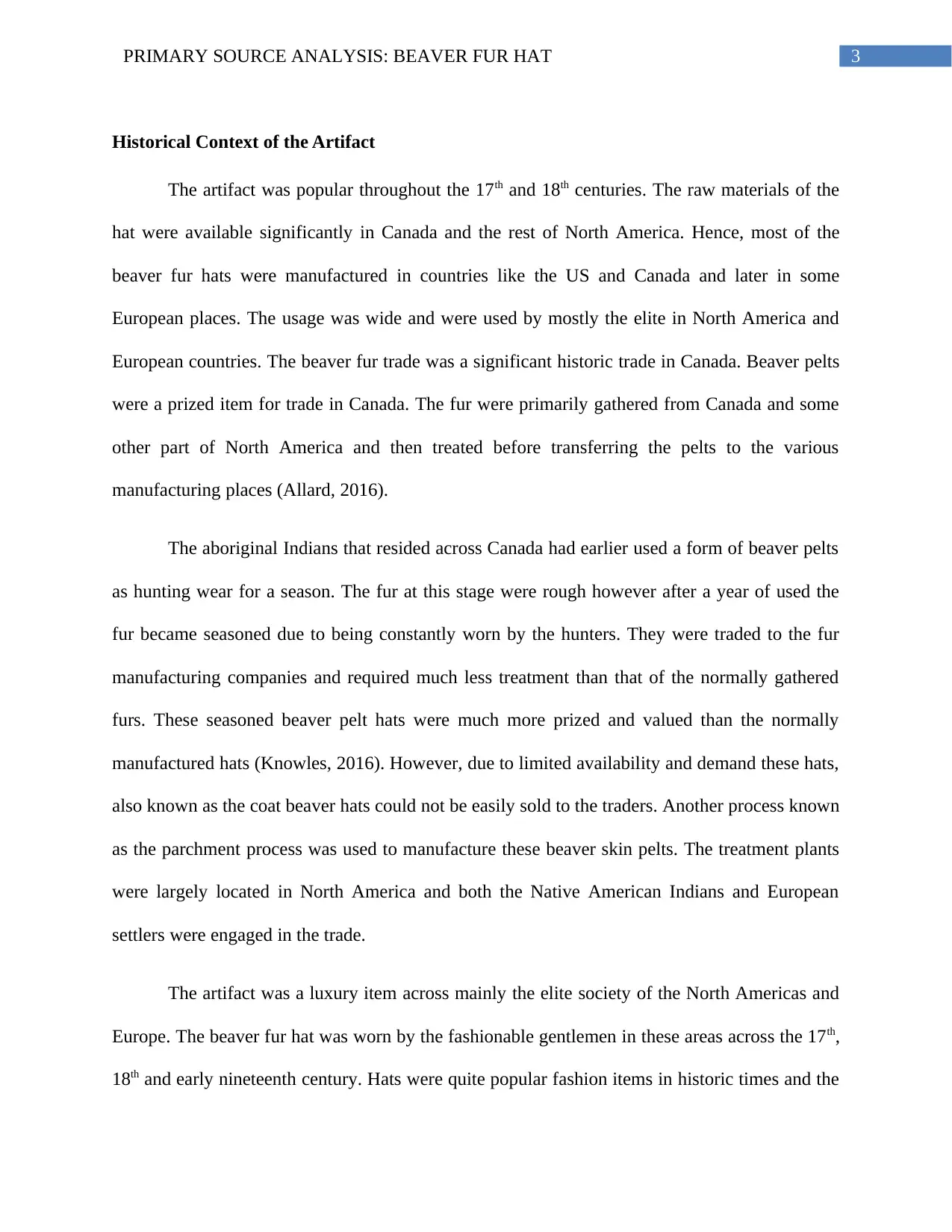
3PRIMARY SOURCE ANALYSIS: BEAVER FUR HAT
Historical Context of the Artifact
The artifact was popular throughout the 17th and 18th centuries. The raw materials of the
hat were available significantly in Canada and the rest of North America. Hence, most of the
beaver fur hats were manufactured in countries like the US and Canada and later in some
European places. The usage was wide and were used by mostly the elite in North America and
European countries. The beaver fur trade was a significant historic trade in Canada. Beaver pelts
were a prized item for trade in Canada. The fur were primarily gathered from Canada and some
other part of North America and then treated before transferring the pelts to the various
manufacturing places (Allard, 2016).
The aboriginal Indians that resided across Canada had earlier used a form of beaver pelts
as hunting wear for a season. The fur at this stage were rough however after a year of used the
fur became seasoned due to being constantly worn by the hunters. They were traded to the fur
manufacturing companies and required much less treatment than that of the normally gathered
furs. These seasoned beaver pelt hats were much more prized and valued than the normally
manufactured hats (Knowles, 2016). However, due to limited availability and demand these hats,
also known as the coat beaver hats could not be easily sold to the traders. Another process known
as the parchment process was used to manufacture these beaver skin pelts. The treatment plants
were largely located in North America and both the Native American Indians and European
settlers were engaged in the trade.
The artifact was a luxury item across mainly the elite society of the North Americas and
Europe. The beaver fur hat was worn by the fashionable gentlemen in these areas across the 17th,
18th and early nineteenth century. Hats were quite popular fashion items in historic times and the
Historical Context of the Artifact
The artifact was popular throughout the 17th and 18th centuries. The raw materials of the
hat were available significantly in Canada and the rest of North America. Hence, most of the
beaver fur hats were manufactured in countries like the US and Canada and later in some
European places. The usage was wide and were used by mostly the elite in North America and
European countries. The beaver fur trade was a significant historic trade in Canada. Beaver pelts
were a prized item for trade in Canada. The fur were primarily gathered from Canada and some
other part of North America and then treated before transferring the pelts to the various
manufacturing places (Allard, 2016).
The aboriginal Indians that resided across Canada had earlier used a form of beaver pelts
as hunting wear for a season. The fur at this stage were rough however after a year of used the
fur became seasoned due to being constantly worn by the hunters. They were traded to the fur
manufacturing companies and required much less treatment than that of the normally gathered
furs. These seasoned beaver pelt hats were much more prized and valued than the normally
manufactured hats (Knowles, 2016). However, due to limited availability and demand these hats,
also known as the coat beaver hats could not be easily sold to the traders. Another process known
as the parchment process was used to manufacture these beaver skin pelts. The treatment plants
were largely located in North America and both the Native American Indians and European
settlers were engaged in the trade.
The artifact was a luxury item across mainly the elite society of the North Americas and
Europe. The beaver fur hat was worn by the fashionable gentlemen in these areas across the 17th,
18th and early nineteenth century. Hats were quite popular fashion items in historic times and the
Paraphrase This Document
Need a fresh take? Get an instant paraphrase of this document with our AI Paraphraser

4PRIMARY SOURCE ANALYSIS: BEAVER FUR HAT
usage of exotic materials like furs made them much sought after luxury items. The hats could be
worn at parties and other social gathering and even on the streets as status symbols. Beaver pelt
was one of the most prized commodity for luxury items at the time.
usage of exotic materials like furs made them much sought after luxury items. The hats could be
worn at parties and other social gathering and even on the streets as status symbols. Beaver pelt
was one of the most prized commodity for luxury items at the time.
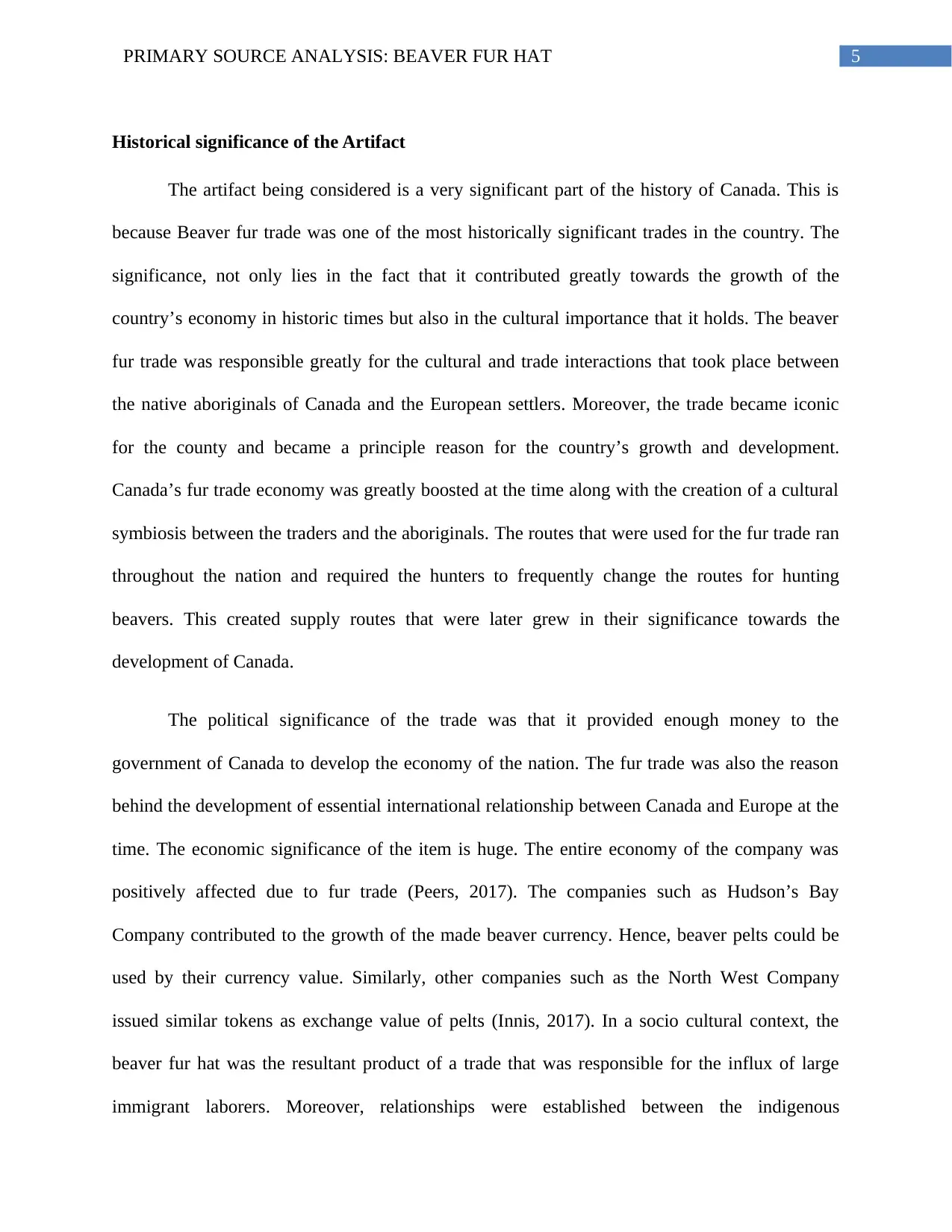
5PRIMARY SOURCE ANALYSIS: BEAVER FUR HAT
Historical significance of the Artifact
The artifact being considered is a very significant part of the history of Canada. This is
because Beaver fur trade was one of the most historically significant trades in the country. The
significance, not only lies in the fact that it contributed greatly towards the growth of the
country’s economy in historic times but also in the cultural importance that it holds. The beaver
fur trade was responsible greatly for the cultural and trade interactions that took place between
the native aboriginals of Canada and the European settlers. Moreover, the trade became iconic
for the county and became a principle reason for the country’s growth and development.
Canada’s fur trade economy was greatly boosted at the time along with the creation of a cultural
symbiosis between the traders and the aboriginals. The routes that were used for the fur trade ran
throughout the nation and required the hunters to frequently change the routes for hunting
beavers. This created supply routes that were later grew in their significance towards the
development of Canada.
The political significance of the trade was that it provided enough money to the
government of Canada to develop the economy of the nation. The fur trade was also the reason
behind the development of essential international relationship between Canada and Europe at the
time. The economic significance of the item is huge. The entire economy of the company was
positively affected due to fur trade (Peers, 2017). The companies such as Hudson’s Bay
Company contributed to the growth of the made beaver currency. Hence, beaver pelts could be
used by their currency value. Similarly, other companies such as the North West Company
issued similar tokens as exchange value of pelts (Innis, 2017). In a socio cultural context, the
beaver fur hat was the resultant product of a trade that was responsible for the influx of large
immigrant laborers. Moreover, relationships were established between the indigenous
Historical significance of the Artifact
The artifact being considered is a very significant part of the history of Canada. This is
because Beaver fur trade was one of the most historically significant trades in the country. The
significance, not only lies in the fact that it contributed greatly towards the growth of the
country’s economy in historic times but also in the cultural importance that it holds. The beaver
fur trade was responsible greatly for the cultural and trade interactions that took place between
the native aboriginals of Canada and the European settlers. Moreover, the trade became iconic
for the county and became a principle reason for the country’s growth and development.
Canada’s fur trade economy was greatly boosted at the time along with the creation of a cultural
symbiosis between the traders and the aboriginals. The routes that were used for the fur trade ran
throughout the nation and required the hunters to frequently change the routes for hunting
beavers. This created supply routes that were later grew in their significance towards the
development of Canada.
The political significance of the trade was that it provided enough money to the
government of Canada to develop the economy of the nation. The fur trade was also the reason
behind the development of essential international relationship between Canada and Europe at the
time. The economic significance of the item is huge. The entire economy of the company was
positively affected due to fur trade (Peers, 2017). The companies such as Hudson’s Bay
Company contributed to the growth of the made beaver currency. Hence, beaver pelts could be
used by their currency value. Similarly, other companies such as the North West Company
issued similar tokens as exchange value of pelts (Innis, 2017). In a socio cultural context, the
beaver fur hat was the resultant product of a trade that was responsible for the influx of large
immigrant laborers. Moreover, relationships were established between the indigenous
⊘ This is a preview!⊘
Do you want full access?
Subscribe today to unlock all pages.

Trusted by 1+ million students worldwide

6PRIMARY SOURCE ANALYSIS: BEAVER FUR HAT
populations and the traders. Environmentally, the trade had negative effects and resulted in the
loss of huge beaver populations across the country.
populations and the traders. Environmentally, the trade had negative effects and resulted in the
loss of huge beaver populations across the country.
Paraphrase This Document
Need a fresh take? Get an instant paraphrase of this document with our AI Paraphraser
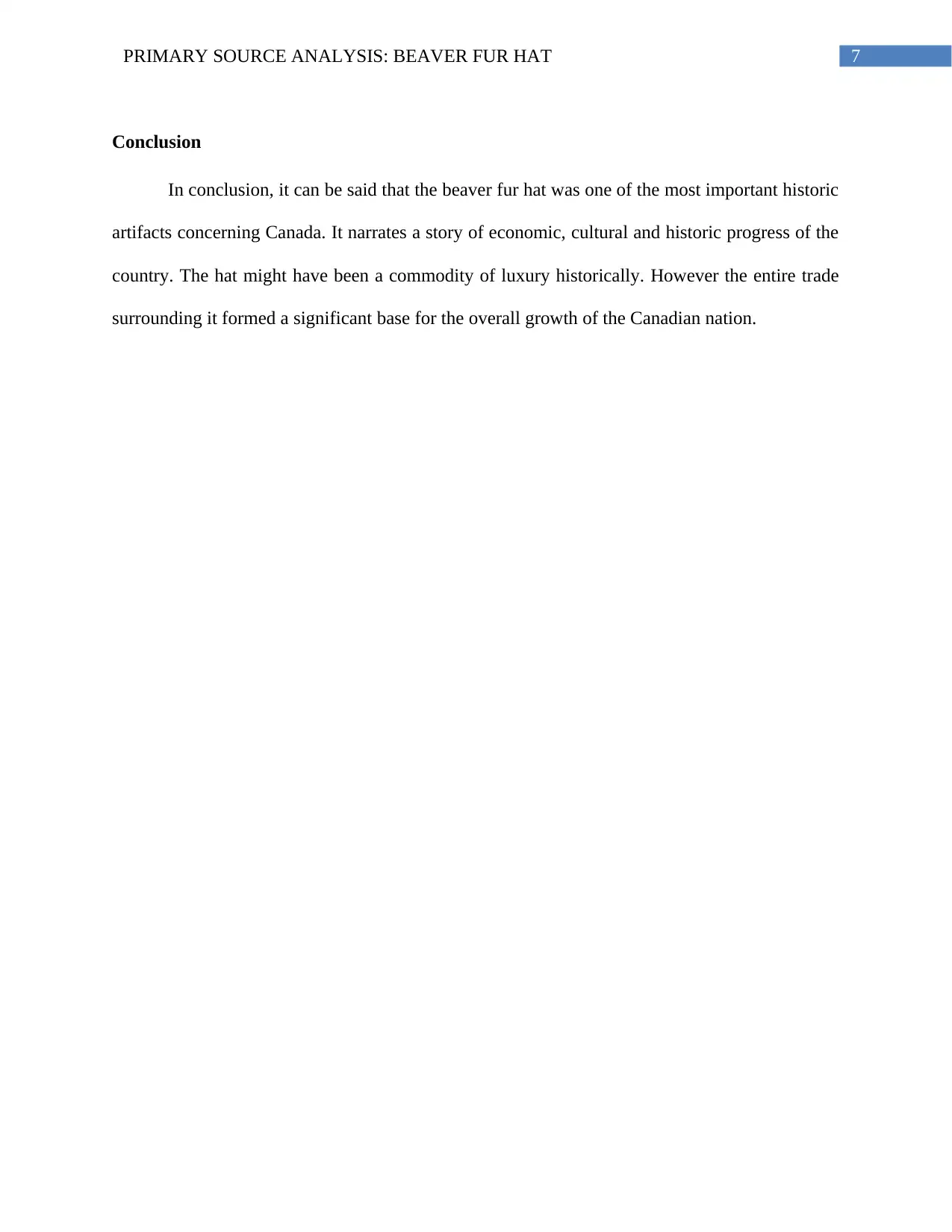
7PRIMARY SOURCE ANALYSIS: BEAVER FUR HAT
Conclusion
In conclusion, it can be said that the beaver fur hat was one of the most important historic
artifacts concerning Canada. It narrates a story of economic, cultural and historic progress of the
country. The hat might have been a commodity of luxury historically. However the entire trade
surrounding it formed a significant base for the overall growth of the Canadian nation.
Conclusion
In conclusion, it can be said that the beaver fur hat was one of the most important historic
artifacts concerning Canada. It narrates a story of economic, cultural and historic progress of the
country. The hat might have been a commodity of luxury historically. However the entire trade
surrounding it formed a significant base for the overall growth of the Canadian nation.
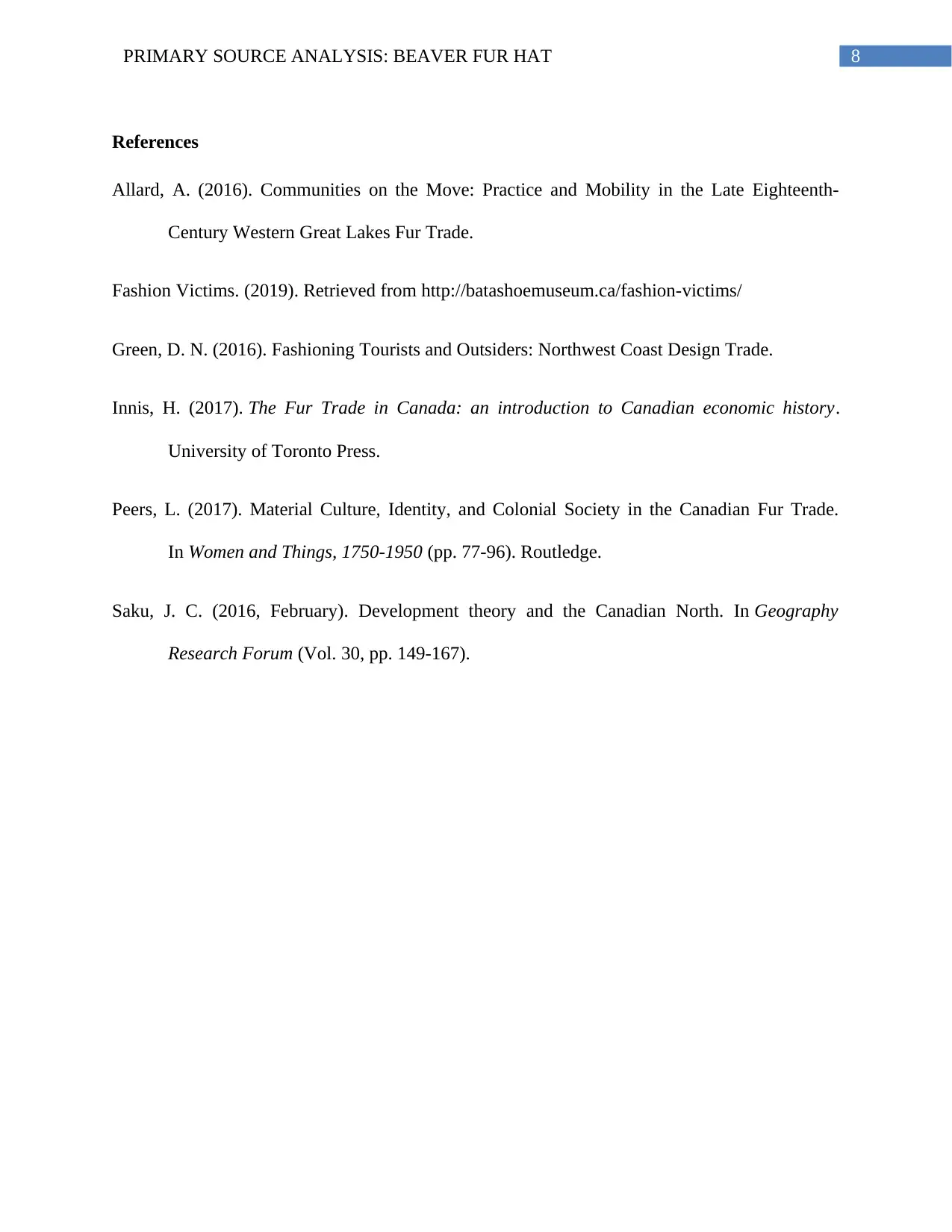
8PRIMARY SOURCE ANALYSIS: BEAVER FUR HAT
References
Allard, A. (2016). Communities on the Move: Practice and Mobility in the Late Eighteenth-
Century Western Great Lakes Fur Trade.
Fashion Victims. (2019). Retrieved from http://batashoemuseum.ca/fashion-victims/
Green, D. N. (2016). Fashioning Tourists and Outsiders: Northwest Coast Design Trade.
Innis, H. (2017). The Fur Trade in Canada: an introduction to Canadian economic history.
University of Toronto Press.
Peers, L. (2017). Material Culture, Identity, and Colonial Society in the Canadian Fur Trade.
In Women and Things, 1750-1950 (pp. 77-96). Routledge.
Saku, J. C. (2016, February). Development theory and the Canadian North. In Geography
Research Forum (Vol. 30, pp. 149-167).
References
Allard, A. (2016). Communities on the Move: Practice and Mobility in the Late Eighteenth-
Century Western Great Lakes Fur Trade.
Fashion Victims. (2019). Retrieved from http://batashoemuseum.ca/fashion-victims/
Green, D. N. (2016). Fashioning Tourists and Outsiders: Northwest Coast Design Trade.
Innis, H. (2017). The Fur Trade in Canada: an introduction to Canadian economic history.
University of Toronto Press.
Peers, L. (2017). Material Culture, Identity, and Colonial Society in the Canadian Fur Trade.
In Women and Things, 1750-1950 (pp. 77-96). Routledge.
Saku, J. C. (2016, February). Development theory and the Canadian North. In Geography
Research Forum (Vol. 30, pp. 149-167).
⊘ This is a preview!⊘
Do you want full access?
Subscribe today to unlock all pages.

Trusted by 1+ million students worldwide
1 out of 9
Related Documents
Your All-in-One AI-Powered Toolkit for Academic Success.
+13062052269
info@desklib.com
Available 24*7 on WhatsApp / Email
![[object Object]](/_next/static/media/star-bottom.7253800d.svg)
Unlock your academic potential
Copyright © 2020–2025 A2Z Services. All Rights Reserved. Developed and managed by ZUCOL.





